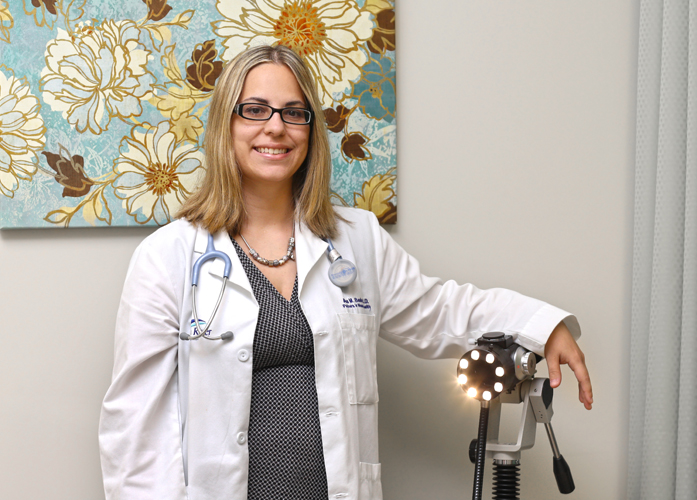Each year, Nancy dreads her annual visit to the gynecologist’s office for a pelvic exam – a far more anxiety-ridden event to her than filing yearly taxes by April 15, keeping up with fast-moving traffic on the interstate or meeting work deadlines. The intimate nature of the exam, the slight discomfort and worry that comes with it, are enough to send her over.
Yet she manages to show up, year after year for the wellness exam, and in the end, feels better for doing so. Meanwhile, others are completely nonchalant about it. They, too, recognize the benefits of doing it far outweigh the potential risks associated with skipping it altogether.
“There are a million other things I’d rather do, but I get myself there and am glad I do,” said the Vero Beach woman who preferred not to use her last name.
The American College of Physicians now says it recommends that doctors quit using pelvic exams annually as a screening tool for healthy non-pregnant women with no complaints. It pointed to the lack of evidence that a gynecologic pelvic exam leads to an improvement in women’s health.
The recommendations aren’t binding on doctors or insurers.
“The potential benefits of pelvic exam include finding cancer, noncancerous masses, or infection before symptoms develop,” the ACP said. As for the downsides: increased medical costs, discomfort and embarrassment. ACP members specialize in internal medicine.
So, to have or have not, each year, remains the question. At the end of the day, that will be decided by both physician and patient.
“A lot of clinical information can be collected from the pelvic exam,” said Dr. Ana Benitez-Prieto, OB/GYN at Partners in Women’s Health in Vero Beach. “If a mechanic doesn’t look under the hood of the car at the engine and says ‘it’s okay,’ he’s probably not a good mechanic.”
“When you go to a cardiologist, if he doesn’t look at your heart, he probably is not a good cardiologist,” she added. “If I don’t do a full pelvic exam, I’m not doing the best to serve the patient’s health needs.”
Pelvic examination is done to screen for disease in non-pregnant, adult women who do not have symptoms. During a pelvic exam, the doctor examines the external genitalia and then inserts a speculum into the vagina to examine it and the cervix. Next, the doctor feels inside the vagina with one hand and then places the other hand on the abdomen to check for abnormalities in the ovaries, uterus and other pelvic organs. This is called a bimanual exam. Sometimes it includes inserting a finger in the patient’s rectum to check for abnormalities there. The doctor also takes samples to evaluate for infection and at certain intervals, Pap smear and HPV tests for cervical cancer screening.
Another physician group, the American College of Obstetricians and Gynecologists, recommends annual pelvic exams. It acknowledged that no current scientific evidence supports or refutes an annual pelvic exam for an asymptomatic, low-risk patient. It recommends the decision about whether to perform a pelvic exam be made jointly by the physician and patient.
Some local gynecologists say they will continue to administer the pelvic exam annually to a patient as long as the patient is willing.
“Women need pelvic exams for cervical pap smear screening, for STD testing and for monitoring birth control,” said Dr. Audrey Richards, board certified OB/GYN at Indian River Gynecology. “Many of these tests, all requiring a pelvic exam, were traditionally performed annually.”
“I am much like most of my patients,” she added. “I want to do the best I can to safeguard my health. Pelvic exams with pap smears, mammograms and colonoscopies are examples of screening tests that result in early detection and have been proven to save lives.”
Several recent recommendations regarding screening tests for women’s health, Richards adds, have declared that the risks outweigh the benefits. The benefits are early detection of disease. The risks have been anxiety, discomfort and embarrassment. “Most women would not place these concerns on the same level as prevention of serious disease,” she said.
If a woman decides to skip the annual pelvic exam, Richards advises her to see a primary care physician for general care and screening tests, including a breast exam and mammogram. At certain intervals, STD screening and pap smears are still needed.
Benitez-Prieto said the pelvic exam is also a good tool for picking up issues with incontinence and sexual dysfunction that may result from a descended uterus – something often experienced by women who have had babies.
“There are therapies that can help improve such symptoms,” she said. “A lot of women aren’t aware of their anatomies, and the issues that may require treatment to help with their quality of life.”
Another possible finding during an exam is an enlarged uterus and if there are fibroids. “Women might think their heavy bleeding is normal, but there may be a reason behind it.”
As for the ACP’s point that women are suffering unnecessary pain, embarrassment and anxiety due to the pelvic exam, Benitez-Prieto says it’s never going to be comfortable.
“Whoever tells me they like their pelvic exam, they need to get their heads checked,” she said. “It’s always a bit uncomfortable but it shouldn’t be painful unless there is some issue.”

